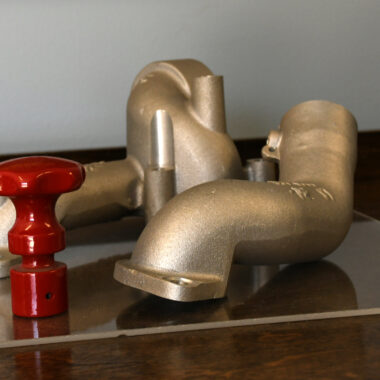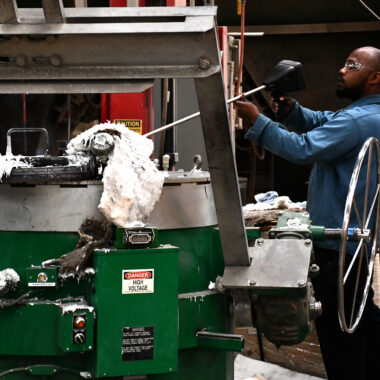Maximizing Performance: Advanced Aluminum Casting Solutions Introduced
Maximizing Performance: Advanced Aluminum Casting Solutions Introduced
Blog Article
The Top Methods for Light Weight Aluminum Spreading That You Need to Know
In the world of aluminum proficiency, spreading and accuracy are extremely important. Comprehending the subtleties of various spreading methods can substantially influence the high quality and efficiency of the end product. From the standard sand spreading approach to the complex investment casting procedure, each strategy supplies distinct advantages that provide to various project demands. As we navigate via the top strategies for light weight aluminum casting, it becomes evident that understanding these approaches is crucial for attaining optimum results. Let's explore the complexities of these methods and just how they shape the world of light weight aluminum casting.
Sand Spreading Strategy
The Sand Casting Method is an essential approach in light weight aluminum spreading, commonly utilized for its cost-effectiveness and versatility in producing complex steel shapes. This technique includes producing a mold and mildew made of compressed sand right into which molten aluminum is poured, enabling it to take the form and solidify of the mold. Among the vital benefits of sand spreading is its capability to create complex geometries with fairly reduced tooling prices, making it an appealing option for producers wanting to create distinct components.
In the sand spreading process, a pattern of the last component is pressed into a fine sand mix had within a flask. Sand spreading is generally used in different markets, consisting of auto, aerospace, and art foundries, due to its ability to create both large and little metal elements with detailed styles.

Investment Casting Process
A detailed method utilized in aluminum casting is the Investment Casting Refine, recognized for its capability to create highly outlined and intricate metal components. Additionally referred to as the lost-wax casting procedure, this strategy dates back thousands of years and remains a prominent selection in various markets because of its convenience and precision - aluminum casting.
The financial investment spreading procedure starts with the development of a wax pattern, which is covered with a ceramic shell to develop a mold. The wax is then thawed out, leaving a cavity in the form of the desired part. Molten light weight aluminum is poured into the ceramic mold, taking and filling the cavity on the intricate information of the initial wax pattern.
This technique is favored for its capability to produce intricate shapes with excellent surface finish and dimensional precision. It is generally used in the production of aerospace parts, jewelry, and industrial equipment where complex styles are required. The investment casting procedure uses high repeatability and can produce parts with minimal machining required, making it an economical choice for numerous applications.
Permanent Mold And Mildew Technique
Using a different technique from the Investment Casting Process, the Permanent Mold and mildew Method in aluminum casting supplies a distinct technique for developing steel elements. In this method, a recyclable mold, commonly made of steel or actors iron, is used to shape the molten aluminum. The mold is preheated to a certain temperature level prior to the aluminum is put right into it. The warmth transfer from the liquified steel to the mold aids in strengthening the light weight aluminum rapidly, lowering the cooling time compared to sand casting.
Among the vital benefits of the Permanent Mold Technique is the enhanced surface area coating and dimensional accuracy of the castings created. This method is additionally recognized for its ability to create high-strength aluminum parts with constant high quality. Additionally, the recyclable nature of the mold makes it a cost-efficient alternative for medium to high quantity production runs.
Die Casting Technology
Utilizing innovative production processes, die casting innovation presents an extremely efficient approach for generating complex light weight aluminum elements. This method entails injecting liquified light weight aluminum right into a steel mold, referred to as a die, at high pressures. The die is particularly made to shape the aluminum into the wanted type, causing high accuracy and outstanding surface area finish.
Die casting offers numerous benefits. It permits the manufacturing of complicated shapes with thin walls, limited tolerances, and smooth surface areas, making it suitable for applications where looks and accuracy are vital. Additionally, pass away spreading makes it possible for rapid manufacturing rates, lowering overall production time and costs.

Lost Foam Spreading Technique
Die casting modern technology's efficiency and accuracy in creating light weight aluminum parts lead the way for discovering the Lost Foam Casting Method as a complementary manufacturing method. Lost Foam Casting, additionally referred to as evaporative pattern spreading, is a method that utilizes foam patterns to produce elaborate light weight aluminum components. This procedure involves producing a foam pattern that is coated with a refractory material to develop a covering. The coated foam pattern is after that buried in sand, and molten light weight aluminum is poured right into the mold, vaporizing the foam as it flows in and takes its shape.
One of the essential advantages of Lost Foam Casting is its ability to produce complicated layouts with elaborate details that might be testing to achieve through standard casting methods. In addition, this technique eliminates the requirement for cores, decreases machining operations, and enables tighter tolerances. Lost Foam Casting is particularly appropriate for tiny to medium-sized light weight aluminum parts that need high precision and intricate geometries. aluminum casting. As markets continue to demand light-weight yet resilient parts, Lost Foam Spreading verifies to be a useful method in the realm of light weight aluminum spreading.
Conclusion
To conclude, comprehending the leading methods for aluminum spreading is vital for achieving high-quality cause the production procedure. Sand spreading, financial investment casting, irreversible mold and mildew, pass away casting, and lost foam spreading are all efficient techniques for generating light weight aluminum components with various levels of complexity. By mastering these techniques, manufacturers can ensure that their items fulfill the wanted specifications and criteria for efficiency and toughness.
From the typical sand casting technique to the complex investment spreading process, each technique offers special advantages that provide to various job needs.The Sand Spreading Strategy is a basic method in aluminum casting, widely used for its cost-effectiveness and versatility in creating complex metal forms. Lost Foam Casting, likewise known as evaporative pattern casting, is a method that uses foam patterns to create intricate aluminum parts. As sectors continue to demand lightweight This Site yet sturdy components, Lost Foam Spreading proves to be a beneficial technique in the realm of aluminum spreading.
Sand spreading, investment casting, long-term mold, Click Here pass away casting, and shed foam spreading are all reliable approaches for creating light weight aluminum parts with different degrees of complexity.
Report this page